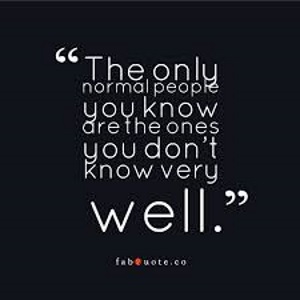“Normality is a figment of someone else’s imagination.” I heard this phrase many years ago. I was sitting in a flat with a couple of people, after a night out, while we passed a joint between us. It was a momentous moment for me. It was the first time I began to feel as if being me was okay. Normal or not, it was still magnificent to be myself.
Normality or not – My back story
I was never a “normal” child. It’s not standard for a child to be considered strange or alien even before school. Child/educational psychologists are not employed to evaluate the average child; this happens when parents, carers or teachers feel there is something wrong. The pattern continued, and I developed into a less-than-normal adolescent, evidenced by a couple of trips to a shrink, and a suicide attempt that, thankfully, didn’t take.
I have never had a best-friend; every friendship that I made was secondary. Every group I made my circle tolerated me on the fringes; I was the third or fifth wheel. And while I occasionally questioned it, it didn’t bother me because it meant I didn’t have to let them too close, I was a supporting character in the screenplay of their lives, while I could assist in their character development, they didn’t need me for their story to unfold.
As I matured beyond senior school and sixth form, I learned to “assimilate” somewhat, my eccentricities hidden from my casual and superficial acquaintances. To appear to be the poster-child of normality, to everyone who didn’t really know me. This was fine for a short while, but I became frustrated with it. Eventually, I found enough external acceptance as my faux self to realise that I didn’t like the fake front I assumed to fit in with those around me. I needed a clean break.
When I finished college (sixth form), I decided to take a gap year and get a job for 14 months. This was a turning point for me because I broke the bonds that had kept me in a holding pattern of Meet-Assimilate-Self-loathing-Repeat. It was necessary to break my habit of changing to fit, or even worse, staying quiet to give the appearance of fitting in. I sought friendships with others on the fringes of the socially acceptable and began to erase the feelings of having to fit to be happy. There came the point when my mother coined the phrase “twilight person” to describe my acquaintances and me.
No, I’m not normal, and neither are you.
It took until a significant chunk of my twenties had disappeared (and I’m still working on it now), meeting my husband, and several other smaller things to genuinely begin t accept myself as I am. I am no more and no less normal than you, the neighbour, or the guy on the bus.
There is a lot of phraseology that has become somewhat buzz-wordy. Neuro-typical and neuro-atypical are often used to describe some people with different ways of seeing and experiencing the world. To my mind, they are simply new ways of saying normal or abnormal. In theory, Neuro-atypical could be used to define my occurrence outside the bell curve of the population, but I’m not going to adopt it.
I’m refusing to adjust to fit a mould that I have never fit. I suppose that this could be taken as a very inflexible stance, but I’m not rigid. I choose when to bend, I no longer let external influence dictate when I should conform to a particular social subset.
Numbers cannot define normality, merely probability
Normality seems to be dictated by numbers and maths, averages, and studies too small to encompass the sheer scale and variety of the human condition. The sectioning of a population of billions into arbitrary units of observable and measurable characteristics of size, shape, colour, opinions, thoughts, emotions….the list is endless.
With such a vast number of physical, mental, emotional, and spiritual facets that make up a person, how can there be any definition of normality? For a person to fall within median ranges of what could be called “normal” for even half of those facets would be spectacularly coincidental.
What about the facets in which individuals fall outside of the average? Any individual will fall into an abnormal bracket in numerous areas. At any one time, a single person will be normal, abnormal, and sitting on the fringes of every single aspect of their being. How can that situation ever be called normal?
There is no Normality
There is no “normal” only the perception of it, perception is subjective and the product of an individual mind, therefore normality is a figment of the imagination. Let’s be fair, normality must be the product of a rather dull imagination.


Pingback: Future plans - The affects of past and present ~ Musing Mamie